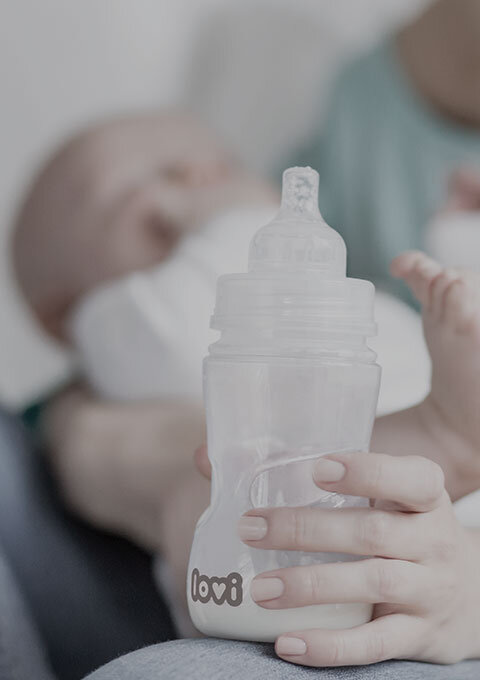Washing, boiling and sterilizing bottles and teats may seem cumbersome, but all these activities are very important for baby's health. Remnants of milk are an excellent medium for bacteria, and baby's digestive system is still immature thus very sensitive. Sloppy washing of feeding accessories can result in food poisoning, diarrhea or fungal infections, such as thrushes. So we would give you some tips on how to ensure their cleanness.
When you plan to feed with a bottle, buy a few of them, so you can prepare a sterile set of bottles for the whole day. For breastfeeding mums one bottle is enough (e.g., to give the extracted milk). During purchase examine a bottle with an eye on its future cleaning; the best are simple bottles without recesses from which it is difficult to remove the remains of a formula.
Bottles and teats should be washed manually, then you can be sure that no formula remained in any recess. A cleaning brush will be necessary; the best is one with two ends, one for bottles and one for teats. Transparent silicone teats are the easiest to clean. Teats of heterogeneous silicone have a thinner end, so you must be careful not to damage it during cleaning.
Before the first use, as well as before any subsequent one you must wash and sterilize the bottle, the teat and the cap. Wash them under running warm water. Do not use any corrosive or strong washing agents, normal washing liquid is enough. After washing, rinse everything thoroughly.
To remove all milk remains use a brush for bottles and teats, and it also should be thoroughly washed and rinsed after each use, and regularly boiled.
If you want to use a dishwasher, check whether a bottle manufacturer allows washing it in a dishwasher, and after taking it out, inspect the bottle for any possible remains of milk in bends and recesses. It is a good practice to rinse it again before boiling or sterilization.
Sterilization guarantees that no fungi or bacteria survive in the bottle or on the teat. There are a few ways to sterilize bottles and teats.
After purchasing and washing the bottle and the teat, boil them for 5 minutes in boiling (bubbling) water. Later you can simply scald the accessories by placing them in a pot and pouring boiling water over them.
There are various types of sterilizers available on the market: electric, steam, for use in a microwave oven, or with a steam cooking function. In the sterilizer, bottles and teats are treated with steam at a temperature exceeding 100°C, so all germs are killed; sterilization lasts several minutes, then bottles can be stored in sterile conditions in the device for several hours. On one hand, the sterilizer means a high one-time expenditure, but on the other hand, it is more convenient than boiling the accessories in a pot, saves water and, most importantly, time.
There are self-sterilizing bottles available on the market. You just pour a specified amount of water into a special cap, put the bottle cap and the teat with a handle inside, connect them to the bottle (by clicking) and put the whole assembly into an appropriately programmed microwave. After 90 seconds the bottle and the teat are sterilized.
In this case, washed bottles and teats must be put into a pot or another vessel with a cover, and, depending on the product, a small amount of liquid should be poured inside, or a water solution with dissolved tablet should be poured over the accessories. After the time specified in a manufacturer's instruction, usually after 30 minutes, the accessories are ready to be used.
It is recommended to sterilize accessories for infant feeding until the baby is 6 months old. However, it is always an individual decision. It may be better to sterilize bottles and teats for longer, when the baby's digestive tract is sensitive, the baby suffers from diarrhea, or thrushes often appear in his mouth. On the other hand, when the baby is already crawling, moves around on the floor, is teething and puts everything into his mouth, sterilization is pointless. When the child is one, you can treat his bowls, cups and bottles in the same way as vessels of other members of the family, but you should frequently replace sponges and tea towels, and maintain the kitchen clean.
Do not wipe bottles and teats after washing and sterilization or scalding. Then it is easy to infect them with bacteria from the towel, or leave lints from a paper towel on them. Wet bottles and teats should be left to dry, so place them, preferably upside down, on a clean cotton cloth or use a special drying rack for bottles and teats.
During bottle feeding it is extremely important to ensure baby's health and safety, by preventing choking or possible problems with his tummy.
"May he grow healthily", this is parent's greatest wish from the moment of baby's birth. Ensuring the baby eats and gains weight correctly is a challenge taken by mothers, and a very difficult and stressful problem when it ...
You dreamed about breastfeeding. It has not worked. You are very upset, struggling with negative emotions, asking questions that hurt even more. You are worrying that bottle-feeding will not provide your baby with everything ...
